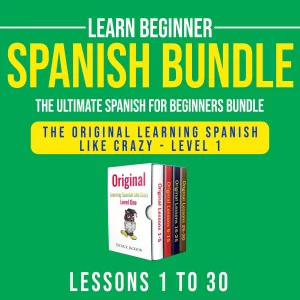
I received an interesting email from a customer. He wrote:
“Hola Patrick, I live in Mexico and I am an English professor here. Most of my friends are native
English-speakers who teach English here in Mexico. My wife is also an American who teaches English here
in Mexico. So even though I live in Mexico I don’t have as many opportunities to speak the language as
most people would think. When it comes to Spanish grammar, I consider myself on a very advanced level.
But I’d like to improve my Spanish conversational skills. I consider myself too advanced to take Spanish classes. Do you have any suggestions?”
How To Improve Your Spanish in a Spanish Speaking Country
One way to improve your Spanish speaking skills is to interact with two (2) or more native Spanish speakers. That way, you will hear not only how they speak to you — but also how they speak to each other.
Sometimes Spanish-speakers will speak to someone who is learning Spanish different from the way they’d speak to a native Spanish speaker. I do this all the time when speaking to someone who doesn’t speak English well — for example, when speaking to a tourist in New York who is asking for directions.
Speaking that way may be very helpful for beginners. But for someone on an advanced level or for someone who wants to accelerate their learning, this may not be quite as helpful.
My advice to that reader is to take some kind of group class in Mexico. He needs to interact more with native Spanish speakers.
One thing that I have noticed about Latin America (or at least in Colombia) people tend to watch less television than Gringos (except for the “mujeres” who like to watch the “novelas”). In Medellín, Colombia it is very common for people to take group classes (instead of staying home watching TV). What kind of group classes?
As I mentioned in a previous blog post, I am taking group classes for Salsa, Bachata and Merengue dancing as well as “artes marciales” (martial arts) classes.

But there are also group classes in Medellín, Colombia for almost any hobby that you can imagine. Here’s a short list:
1. Escuelas de baile (dance)
2. Escuelas de ajedrez (chess)
3. Escuelas de artesanías (arts & crafts)
4. Escuelas de buceo (scuba diving)
5. Escuelas de cine (film)
6. Escuelas de dibujo (drawing)
7. Escuelas de culinaria/cocina/gastronomía (cooking)
8. Escuelas de pintura (painting)
9. Escuelas de yoga (yoga)
10. Escuelas de yudo (judo)
11. Escuelas de patinaje (skating)
12. Escuelas de fútbol (soccer)
13. Escuelas de fotografía (photography)
14. Escuelas de idiomas (languages)
15. Escuelas de natación (swimming)
16. Escuelas de música (music)
17, Escuelas de joyería (jewelry)
18. Escuelas de masajes (massage)
19. Escuelas de meditación (meditation)
20. Escuelas de tejidos (knitting)
21. Escuelas de tenis (tennis)
22. Escuelas de artes gráficas (graphic arts)
23. Escuelas de artes dramático (dramatic arts)
24. Escuelas de karate (karate)
25. Escuelas de panadería (baking)
There’s another way you can interact with groups of native Spanish speakers if you live in Latin America. I am almost too embarrassed to mention this one. That’s because it is one of my New Year’s
Resolutions and we are now in May and I have not done anything about it. I am talking about “trabajo voluntario” (volunteer work).
Ofrezca sus servicios — offer your services — to a “caridad” (charity) or some chartible cause. Here in Medellín there are opportunities to work with a “hospital infantil” (children’s
hospital) and an “orfanato” (orphanage).
Not only is this an effective way to quickly improve your Spanish, but it is also allows us to help charitable causes.






Checking out jili30 for the first time. Looks like they have some cool promotions and bonuses. Worth a look! See the deals at jili30
TONY20251204test. Những điểm ấn tượng chỉ có tại nhà cái 888slots
Với giao diện mượt mà và ưu đãi hấp dẫn, MM88 là lựa chọn lý tưởng cho các tín đồ giải trí trực tuyến.
kuwin sở hữu kho game đa dạng từ slot đến trò chơi bài đổi thưởng, mang đến cho bạn những giây phút giải trí tuyệt vời.
Tham gia cộng đồng game thủ tại Go88 để trải nghiệm các trò chơi bài, poker phổ biến nhất hiện nay.
Đến với J88, bạn sẽ được trải nghiệm dịch vụ cá cược chuyên nghiệp cùng hàng ngàn sự kiện khuyến mãi độc quyền.
搭载智能站群程序,自动化搭建与管理,为SEO项目提供核心驱动力。站群程序
iwin – nền tảng game bài đổi thưởng uy tín, nơi bạn có thể thử vận may và tận hưởng nhiều tựa game hấp
Tham gia cộng đồng game thủ tại Go88 để trải nghiệm các trò chơi bài, poker phổ biến nhất hiện nay.
采用高效谷歌外推策略,快速提升网站在搜索引擎中的可见性与权重。谷歌外推
Tham gia cộng đồng game thủ tại Go88 để trải nghiệm các trò chơi bài, poker phổ biến nhất hiện nay.
iwin – nền tảng game bài đổi thưởng uy tín, nơi bạn có thể thử vận may và tận hưởng nhiều tựa game hấp
I don’t think the title of your article matches the content lol. Just kidding, mainly because I had some doubts after reading the article.
Barınaktan, sokaktan ya da gönüllülerden sahiplendirilen sevimli dostlarımız sahipleniyorum.com’da sizi bekliyor. Hayvanseverler için hazırlanan modern arayüzü ve hızlı filtreleme seçenekleriyle aradığınız dostu kolayca bulun.